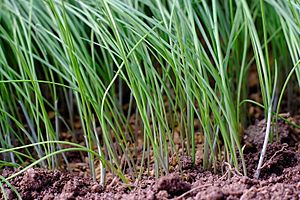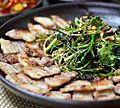Korean wild chive facts for kids
Quick facts for kids Korean wild chive |
|
|---|---|
 |
|
| Korean wild chive in Seosan, Korea | |
| Scientific classification | |
| Genus: |
Allium
|
| Species: |
monanthum
|
| Synonyms | |
|
|
The Korean wild chive, also known as Allium monanthum, is a special spring vegetable. It has tiny roots that look like small bulbs and taste a bit like a mild onion. You can find this plant growing in the forests of Korea, Japan, and parts of northeastern Russia and China.
About the Korean Wild Chive
Allium monanthum is quite unique among plants in its family. Usually, it is dioecious, which means it has separate male and female plants, each with different flowers. Sometimes, though, you might find plants with both male and female parts, or even plants with female and "perfect" flowers (which have both male and female parts).
This plant grows a single round bulb, which is about 1 centimeter (0.4 inches) across. Its flower stalks, called scapes, are quite short for this type of plant, usually less than 10 centimeters (4 inches) tall. The leaves are flat, long, and narrow, and they are longer than the flower stalks.
The flowers grow in small clusters called umbels. Female plants usually have just one flower in their cluster, while male plants have about 4 to 5 flowers. All the flowers can be white, pink, or red.
How Korean Wild Chives Are Used
Korean Culinary Uses
In Korean, the wild chive is called dallae (달래). It's a popular ingredient in Korean cooking, especially in dishes made with "mountain vegetables" called san-namul. Other mountain vegetables include deodeok and angelica-tree.
Korean wild chives taste a bit like tree onions. They can be eaten in many ways:
- Raw or Blanched: They are often served as a namul, which is a seasoned vegetable dish.
- Pickled: They can be pickled to make a dish called jangajji.
- Pan-fried: They are also used to make buchimgae, which are savory pancakes.
As a herb, Korean wild chives are a great last-minute addition to stews. They are often added to doenjang-jjigae (a soybean paste stew) and other types of jjigae (stews). Many Soy sauce-based dips are also flavored with these chives.
In North Korea, a type of radish water kimchi that is flavored with Korean wild chives is a popular banchan (side dish) in the spring.
-
Dallae-muchim (seasoned wild chives) served with samgyeopsal (grilled pork belly).
-
Dallae-bulgogi (a type of grilled meat dish with wild chives).
-
Dallae-doenjang-guk (soybean paste soup with wild chives).





